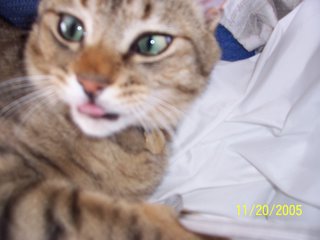Catnip ... die feite! (deesdae Tom se gunsteling happie)

Catnip...and How it Affects Your Cat's Behavior
by: Dr. Nicholas Dodman
For all our scientific know-how, we still have not uncovered the secret of why cats are attracted to catnip. According to a dictionary definition, “catnip is a strong-scented mint (Nepeta cataria) that has whorls of small, pale flowers in terminal spikes and contains a substance attractive to cats.” But though still a mystery, the substance that attracts cats has been isolated. It’s a volatile turpenoid, and has a specific chemical name: nepetalactone. Nepetalactone is not attractive to all cats; only about 30 to 70 percent of cats are actually attracted to it. But when it works, it really works, appearing to drive cats wild with excitement.
The Catnip TripA cat reacts to catnip with ecstasy and unbounded joy. They are given to:
· Sniffing, chewing and batting around the catnip source, salivating profusely
· Shaking their heads
· Rolling and rubbing themselves on the floor
· Becoming ataxic, falling and stumbling
· Tandem kicking forward with the hind feet
· Excitement and chasing behavior Theories Behind CatnipNo one really knows why catnip is such a big attraction for cats. It is also unclear what sensations it is eliciting and what behavior(s) it is releasing. Here are a few possible explanations and discussion of the points that arise:
· Some of the behaviors look play-like, so cats under the influence of catnip do seem to be in a good mood and having fun.
· Chewing and salivating appears to be an appetitive response, one that is associated with getting food.
· Rolling and rubbing appear to be a sexual behavior mimicking being in heat.
· Tandem hind leg kicking behavior may indicate predatory behavior.
· Chasing behavior also indicates a predatory component.So Which Explanation Is It?It may be that they all are correct. Catnip, it seems, kindles a little bit of everything, exciting cats and allowing them to let go of their inhibitions. This implies a general excitatory effect on areas of the brain, particularly those centered in and around the hypothalamus, the region that controls appetitive, predatory and sexual behavior.Recent evidence is that nepetalactone, whose molecule has an opioid (opium-like)-shape, does indeed have an opium-like action. It stimulates certain types of opioid receptors in the same way morphine does. You might ask why an innocent plant would be harboring such a powerful chemical. The answer may be to attract insects that will subsequently assist in cross-pollination or help plants in other ways (e.g. wasps that are attracted will eat aphids). Lamiaceae-type plants may have evolved the ability to manufacture cyclopentanoids, known insect sex pheromones, to attract insects to assist in their own reproductive cycle.Along comes a cat with a nose for fun, discovers this interesting, perhaps pheromonally-attractive plant, which it proceeds to investigate and perhaps to chew. If he or she actually absorbs nepetalactone, the opioid-receptors, pleasure centers, and “go” systems of the brain will be activated and the cat will roll around in ecstasy. It has been shown that exposure to nepetalactone has an amphetamine-like effect in some animals and will cause certain repetitive behaviors. This goes along with the theory of opioid activation, as opioids, in some species – cats and horses included – do cause stimulation of “go system” neurochemicals (a.k.a. catecholamines), as amphetamine does. ConclusionAll this may sound a little far-fetched but does explain the known, observable facts. It also explains why some cats are immune. If a cat that is initially attracted to catnip does not ingest the material, it will not discover the “forbidden fruit” and will thus remain indifferent to the covert pleasures. Although it seems logical to assume that the estrus-like behaviors released by catnip would be a female-only phenomenon, this is not the case. Males, too, engage in rolling and rubbing behavior characteristic of estrus. This can be explained by the fact that no behavior is unique to any one sex, not even a sexual behavior. Although some people may be philosophically opposed to the drunken, appetitive, and seemingly erotic state that catnip produces, it has not been shown to be harmful and may even be beneficial in some circumstances. Catnip-sensitive, feuding cats have been made to perceive each other in a new light following the application of catnip to one or both cats. Also, the analgesic properties of catnip may be helpful for cats in pain. It seems that catnip in cats has similar effects to marijuana in people. Luckily we don’t need a campaign to legalize catnip for medical use in our feline friends.

0 Comments:
Post a Comment
<< Home